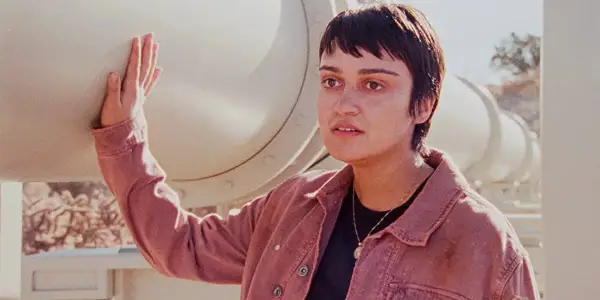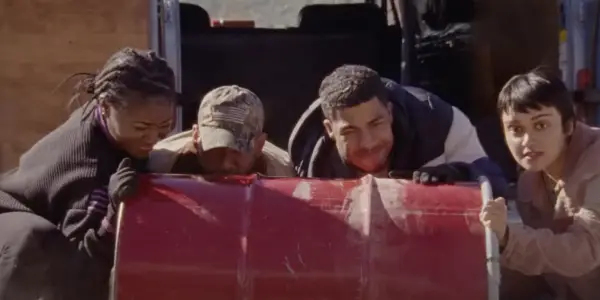Writer And Director Daniel Goldhaber Turns A Manifesto Into A Captivating Crime Thriller In HOW TO BLOW UP A PIPELINE

John Bizub is a 20-year-old film student at Fairfield University…
Ever since the pandemic has allowed access to moviegoers to return to cinemas, many of the stories being told throughout the past three years have an emphasis on spectacle. How could movies not only be gargantuan pieces of entertainment but how could the sequences within the frames captured on camera push the boundaries for what cinema can explore?
Jordan Peele‘s latest film, Nope, not only is the film about capturing a colossal extraterrestrial being through a moving camera and getting “the perfect shot”, but also deconstructs what audiences are attracted to in their media consumption. Audiences are drawn to the unthinkable stories or the images and videos that excite and thrill, hence why the two lead characters desperately attempt to create their own version of “the Oprah shot”.
However, in terms of filmmaking, Daniel Goldhaber stretches this idea into a nearly two-hour film with his latest How To Blow Up A Pipeline.
From Page to Screen
Based on the novel/manifesto of the same name by Andreas Malm, How To Blow Up A Pipeline tells the story of seven young environmental activists taking a stance and stopping the development of a pipeline in Texas and doing so by forms of sabotage. The film stars Lukas Gage, Sasha Lane, Jake Weary, Ariela Barer, Kristine Froseth, Forrest Goodluck, Jayme Lawson, and Irene Bedard. As I mentioned previously, the original text acts as a manifesto on the current environmental state of the world, and Malm‘s very adamant disappointment with corporate executives on the problems they are causing cataclysmic harm rather than good. Unlike the film the novel is adapted from, there are no characters, no plot structure, and so on. Throughout the film, characters poke fun at the original novel’s lack of information on the actuality behind the title of the novel. “They show you everything except how to do it,” one of the characters in the film replies. However, Goldhaber finds new ways of turning the novel into an intense, and dynamic heist thriller that never lets go until the film’s final moments, and even then, things are not all bursts of sunshine and rainbows.
How To Blow Up A Pipeline truly excels at intensifying the stacking of the dominos, all for things to amp up to an eleven from then on. Goldhaber not only creates a tightly-contained and wonderfully crafted heist thriller but constructs the film where nearly every character has a purpose and piece to the film’s larger puzzle. The cinematography is delightful, with every shot feeling massive in scope, providing the setting of Texas to be incredibly captivating, while also feeling colorful with its color palette. The intricate and fast-paced camerawork emphasizes the cringe-worthy “life or death” of both the creation of the chemical bombs and the destruction of the pipeline to be so vast and expansive, making our characters feel small in the large vistas centered in the world.

Daniel Garber‘s editing truly packs such a ferocious punch, with every cut feeling like a dice roll on the character’s consequences from planning the sabotage or simply the event itself. At times making the “ticking time bomb” feeling of the structure of the film work wonders. Pipeline‘s pacing is completely captivating and engaging, The synth-based score by Gavin Brivik feels so pulse-pounding and even harkens back to compositions by Tangerine Dream and at times Aphex Twin, however, with these comparisons Brivik and Goldhaber make each scene heightened up to nearly every odd presented to the characters feeling stacked against the world. Goldhaber‘s political stance provides viewers to feel involved in the conversation and near relatability for the characters and their dilemmas.
On paper, How To Blow Up A Pipeline feels like something that audiences have become familiar with in terms of story structure. But, Daniel Goldhaber creates a universally powerful story but is not afraid of shying away from having fun with its genre expectations and tropes. Especially given his previous work and what he would go on to work on in the future with his Faces of Death remake. A film about young people taking a stance against the cruelty and non-importance regular bystanders have with the idea of climate control by bigger businesses, makes it so valuable to discuss and provide a film with audience-friendly genre excitement and thrills. And this, in my mind, makes Daniel Goldhaber one of the most exciting filmmakers to be working in cinema recently.
This interview has been edited for clarity.
Daniel Goldhaber: Hello! Nice to meet you!
John Bizub for Film Inquiry: Thank you very much for taking time out of your busy schedule! I just wanted to say that I loved Cam and How To Blow Up A Pipeline knocked my socks off!
Daniel Goldhaber: Ah! Thank you so much, man!
I just had a couple of questions that I had been dying to ask you after initially watching the film. So what made you want to tackle this material and when did you first discover the novel?
Daniel Goldhaber: Yeah. So in terms of climate change, my parents have worked in climate science my whole life, so this issue is something that has been close to my heart since I was born, more or less. And my first job in film were working in climate change documentaries, so working in the kind of awareness industry. And I think that there had been a growing sense of resentment and frustration on my part at just how slowly the climate conversation was progressing. And so a big kind of personal inspiration with this project was just to do what I could as a filmmaker to just try to move that conversation forward just a little bit more specifically as to how the book, which is actually a manifesto, it’s a nonfiction work. It’s essentially an essay advocating for the destruction of fossil fuel infrastructure to fight climate change. And in the film, we found the book.

Jordan Shoal, who’s one of the writers on the movie, he’s been a long-time collaborator of mine. He found the book, and he is actually an academic, so he’s kind of always threatened to adapt a work of academic theory into a film and then found something that, you know, suggested an extremely exciting and fun heist movie. And so Jordan found the book, and I, he and Ariel [Barer] had been kind of potted up during the pandemic for a couple of months and had really wanted to find something to work on together and stumbled across this project somewhere we could all collaborate. So after I read the book, I kind of had this image of a bunch of kids in the desert struggling with a bomb. And I think that’s kind of what suggested that we could take this manifesto and adapt it into maybe a heist film, something that was kind of an action movie. And we did about two months of research, talking to activists, spawn experts, and pipeline experts, trying to figure out the kinds of people who would do something like this and why they would do it. And then Ariel was the one who very much kind of took that initial research and figured out how to put it together and came up with the ensemble and wrote that opening ten pages where they all kind of band in their lives. And that was something that really set the tone and the rhythm of the movie. I could see an influence of the Oceans movies.
I could see alot of influence of the Oceans movies. My next question was actually going to be along with that aspect of not only turning the book that was originally a manifesto into a genre heist thriller but why’d you want to make that angle specifically to make it like a genre film?
Daniel Goldhaber: I’m a big heist movie fan. I mean, Oceans Eleven is one of my favorite films of all time. But when it comes to kind of this project, I think that it was twofold. I think that the subject matter does suggest a really kind of novel and exciting, you know? Extremely contemporary action heist film, but also from the standpoint of what we’re talking about, about trying to ask this question in a big way, you know, what kind of tactics and strategies are necessary for the climate movement to prevent a climate apocalypse? And I think the best way for us to ask that question in a mainstream capacity is through genre filmmaking, through action filmmaking, through something that’s commercial and poppy and fun and accessible. And so that was also something that was kind of inherent to our approach from the beginning.
From the film, there’s one quote that stuck out to me. It’s when you poke fun, or I saw it as really poking fun at the original text was that two characters are in a bookstore and one of them says, “They show you everything but don’t tell you how to do it.” Was this intentional on you and the writer’s behalf making it poke fun at the original text’s flaws?
Daniel Goldhaber: Yeah, absolutely. I mean, it’s a bit of an in-joke. There are a lot of moments in the movie where we wanted to acknowledge our own place in this subject and acknowledge the fact that in the documentary film scene, we are not activists, we are filmmakers and we are storytellers. There is something complicated about that position in this movement. And in terms of the book, it’s both the most common criticism the book has gotten, but I think it’s also a little bit of a wing at the fundamental differences between the book and the movie, where the movie does show you how to do it. And there’s not a literal recipe, but the steps that are shown in the movie are steps that are actually reasonable steps that could be carried out by somebody. I think that was, again, part of us just acknowledging the way that this movie exists in the world of ourselves that we live in.

My favorite aspect of Pipeline was, I think, the score. I think the heavy emphasis on sense and IDM mix. It reminded me a lot of the Akira score and Aphex Twin. What were your main influences for making the score for Pipeline or coming up with it?
Daniel Goldhaber: Man, I know that Gavin loves Aphex Twin. I think for us, we were really listening to a lot of Tangerine Dream. That was a big one. And we were listening to a late-breaking inspiration the Blade Runner score. We were looking for a sound of the apocalypse to hang over the movie. And we thought it was really interesting, quoting this film that is about this dystopian future, but doing that and setting it so firmly in the present.
Any favorites by Tangerine Dream? I just have to ask I’m a big fan!
Daniel Goldhaber: I mean, the Thief score was the one that we were thinking about a lot. And it’s really funny because I think that the movie gets a lot of comparisons to Sorcerer, but there is not a point in time during making this movie that movie ever came up. We weren’t thinking about the Sorcerer score. I haven’t seen Sorcerer in 10 years, but it’s just funny that there was some Sorcerer DNA that never found its way into this project.
I did some research about the filming behind this, so I just need to ask you, you shot this on 16mm, correct? What was it like shooting on film? And were there any challenges when filming certain scenes?
Daniel Goldhaber: Yeah. We chose to shoot on film because the whole movie is, not the whole movie, but a lot of the movie is the theory of the exteriors. And we really wanted to lend a tactical, immediate quality to the picture. And you only get that with daylight exteriors on 16mm on cellulite. Because when you shoot daylight on digital, you just have to grade the shit out of it and make it look good. And that makes it a little bit more of a fraudulent image. We didn’t want this to look like a Levi’s ad. But also shooting on film creates an immediacy to the production. It creates a scarcity between when you call to action to when you call cut. You can hear the camera. It’s a little bit of magic. And I think that that just gets a different performance out of your actors, out of your crew. It just creates the magic of the moment of filming. And I think that that’s something that also l end a real truth and reality to the production.
And my last question is, and I don’t think I could really ask you this. I don’t know how far in production you are, but I’m very much interested and very much excited about your Faces of Death remake. I’m a huge fan of the original source material. And I was wondering if you’re going to maintain that grindhouse approach that the original film captures since you shot How to Blow Up a Pipeline on 16mm.
Daniel Goldhaber: I would say that there are aspects of that approach that are definitely a part of what we’re doing. But I also think that what we’re doing is really going to shock and surprise people in a lot of different ways. So it’s definitely a stylistic departure for me and something I’m very excited about.
Film Inquiry would like to thank Daniel Goldhaber for taking the time to speak with us!
Watch How to Blow up a Pipeline
Does content like this matter to you?
Become a Member and support film journalism. Unlock access to all of Film Inquiry`s great articles. Join a community of like-minded readers who are passionate about cinema - get access to our private members Network, give back to independent filmmakers, and more.
John Bizub is a 20-year-old film student at Fairfield University and has loved film for their entire life! When John is not watching and reviewing movies, they are listening to music, another passion for them, as well as playing video games!












